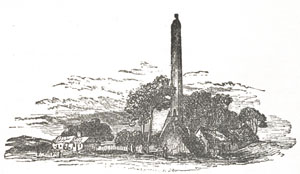Blefed or the Plague

Clondalkin Round Tower
Pestilence of the Blefed—The Cursing of Tara by St. Rodanus—Extent and Importance of Ancient Tara—The First Mill in Ireland—The Lia Fail—Cormac's House—The Rath of the Synods—The Banqueting Hall—Chariots and Swords—St. Columba—St. Brendan and his Voyages—Pre-Columbian Discovery of America—The Plague again—St. Columba and St. Columbanus—Irish Saints and Irish Schools—Aengus the Culdee.
[A.D. 543—693.]

ROM time to time, in the world's history, terrible and mysterious pestilences appear, which defy all calculation as to their cause or probable reappearance. Such was the Blefed, [7] or Crom Chonaill, which desolated Ireland in the year 543.
The plague, whatever its nature may have been, appears to have been general throughout Europe. It originated in the East; and in Ireland was preceded by famine, and followed by leprosy. St. Berchan of Glasnevin and St. Finnen of Clonard were amongst its first victims.
Diarmaid, son of Fergus Keval, of the southern Hy-Nial race, was Ard-Righ during this period. In his reign Tara was cursed by St. Rodanus of Lothra, in Tipperary, in punishment for violation of sanctuary;[8] and so complete was its subsequent desertion, that in 975 it was described as a desert overgrown with grass and weeds.
But enough still remains to give ample evidence of its former magnificence. An inspection of the site must convince the beholder of the vast extent of its ancient palaces; nor can we, for a moment, coincide with those who are pleased to consider that these palaces consisted merely of a few planks of wood, rudely plastered over, or of hollow mounds of earth. It is true that, from an association of ideas, the cause of so many fallacies, we naturally connect "halls" with marble pavements, magnificently carved pillars, and tesselated floors; but the harp that once resounded through Tara's halls, may have had as appreciating, if not as critical, an audience as any which now exists, and the "halls" may have been none the less stately, because their floor was strewn with sand, or the trophies which adorned them fastened to walls of oak.[9]
Notes
[7] Blefed.—The name Crom Chonaill indicates a sickness which produced a yellow colour in the skin.
[8] Sanctuary.—This may appear a severe punishment, but the right of sanctuary was in these ages the great means of protection against lawless force, and its violation was regarded as one of the worst of sacrileges.
[9] Oak.—Dr. Petrie mentions that there were stones still at Tara which probably formed a portion of one of the original buildings. It was probably of the Pelasgian or Cyclopean kind.
